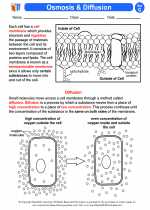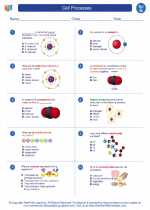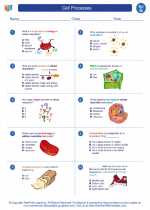Mitochondria
Mitochondria are membrane-bound organelles found in the cytoplasm of eukaryotic cells. They are often referred to as the powerhouses of the cell because they are responsible for producing the majority of the cell's supply of adenosine triphosphate (ATP), which is used as a source of chemical energy.
Structure of Mitochondria
Mitochondria have a unique double membrane structure. The outer membrane is smooth, while the inner membrane is highly folded into structures called cristae. These folds increase the surface area of the inner membrane, allowing for more efficient ATP production. The space inside the inner membrane is called the matrix, which contains enzymes responsible for the reactions of the citric acid cycle (also known as the Krebs cycle) and the electron transport chain, which are the processes involved in ATP production.
Functions of Mitochondria
1. ATP Production: Mitochondria are the primary sites for ATP production through cellular respiration. They use oxygen and organic molecules, such as glucose, to generate ATP through the process of oxidative phosphorylation.
2. Regulation of Cell Metabolism: Mitochondria play a crucial role in regulating cellular metabolism by integrating signals from the cell and the environment to adjust the rates of ATP production based on the energy needs of the cell.
3. Apoptosis: Mitochondria are involved in initiating the process of programmed cell death, or apoptosis, by releasing certain proteins that trigger the cascade of events leading to cell death.
Study Guide
- Describe the structure of mitochondria and explain the significance of their double membrane.
- Explain the process of ATP production in mitochondria, including the role of the citric acid cycle and the electron transport chain.
- Discuss the importance of mitochondria in regulating cellular metabolism and energy production.
- Describe the role of mitochondria in apoptosis and its significance in the context of cellular function and health.
- Compare and contrast the functions of mitochondria with other organelles in the cell, such as the endoplasmic reticulum and the Golgi apparatus.
Understanding the structure and functions of mitochondria is essential for gaining insights into cellular energy production and metabolism, as well as the broader implications for cellular health and disease.
.◂Science Worksheets and Study Guides Seventh Grade. Cell Processes

 Activity Lesson
Activity Lesson
 Worksheet/Answer key
Worksheet/Answer key
 Worksheet/Answer key
Worksheet/Answer key
 Worksheet/Answer key
Worksheet/Answer key
 Worksheet/Answer key
Worksheet/Answer key
 Vocabulary/Answer key
Vocabulary/Answer key
 Vocabulary/Answer key
Vocabulary/Answer key
 Vocabulary/Answer key
Vocabulary/Answer key
 Vocabulary/Answer key
Vocabulary/Answer key
 Vocabulary/Answer key
Vocabulary/Answer key
 Vocabulary/Answer key
Vocabulary/Answer key
 Vocabulary/Answer key
Vocabulary/Answer key
